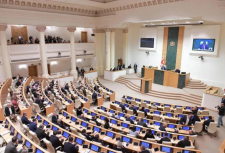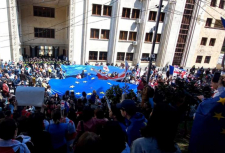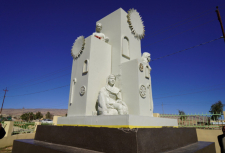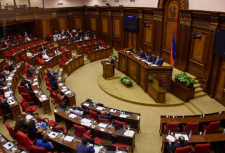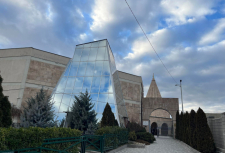The Reign Of Hisen Beg Dasini 1534
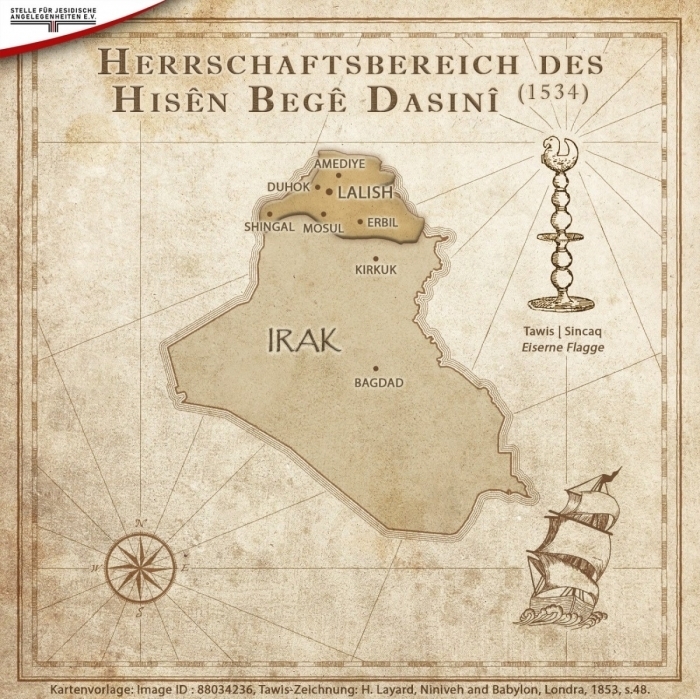
Hisen Beg Dasini (Hussein Beg Dasini) is considered one of the most important figures in the history of the Yazidis. In 1534, he ruled from Mosul via the Emirates of Behdinan with Amedia as its capital and Soran with Erbil as its capital. Thus, he also ruled regions that were mostly populated by Muslims. Its approximate territory is highlighted on the map that we created. As a religious leader of the Yazidis called Mir, he ruled over much more territory than is marked on the map.
During the heyday of Yazidi life, from the 12th to the 17th centuries, the Yazidi elite built seven large principalities with an independent administrative apparatus. Every year or every six months, kevals (trained itinerant preachers) are sent with military protection from the Central power structure and spiritual center of Lalish to the Yazidi principalities. They taught the population of the Yezidi religion and received donations. Each of these seven principalities had a special and unique "Sincaq", the bronze standard of the Sinkaki-iron flags that serve as the administrative symbol of the center of power on Lalish. They were different in shape. During their annual pilgrimage through the Yazidi principalities, delegates carried the appropriate Sincaq as a symbol of authority to symbolize the authority of Lalish. Sincaq Kevalam also given the right and power to judge people. Only the Principality of Seyhan (Weltreich) are not affected, other principalities broke during the event centuries marked by war and persecution.
1. Tavisa Enzel (Velatsheyk-Lalish)
2. Tavis Kangale (Big Singal)
3. Tavis Hectare (sometimes called Tavis Zuzana, she advocated for Yazidis living in the mountains of the region, Cizre)
4. Tavisa Velate Xalt (areas South of van, i.e. areas around Siirt, Batman, Diyarbekir, Mardin, Urfa, etc.)
5. Tawisa Khelebe (Kilis, Aleppo, Afrin, this region was under the rule of the Sheikh mend family)
6. Tawisa Tewrêzê (meaning the city of Tabriz, located in modern Iran. The Yazidis lived in the surrounding area to the West in the Khoy region)
7. Tavisa Miskofa (previously this name was Tavisa Serkhede, the name was changed to Moscow after the Yazidis emigrated to the Russian Empire, this name was used for 200 years)
During the reign of Hisan Beg Dasini, the Yazidis had enormous political and military power and freedoms that the Yazidis were never granted in the Ottoman Empire. Hisan Beg Dasini comes from the qatani Sheikh group and was the son of Hasan beg, also known as Sultan. Hasan beg gained immense power through skillful political and diplomatic actions.after the battle of Haldiran between the Ottomans and Safavids in 1520, He allied with the victorious Ottomans and was able to bring Mosul under his rule. Until his death in 1534, he used his power to pacify his ruling region and improve living conditions. From 1534, his son Hisen Beg succeeded him. Through him, his Principality experienced an economic heyday that made it known beyond its borders and helped the Yazidis at the height of their political power.
Initially, the Yazidis under the leadership of Hisen Beg Dasini managed to repel all attacks. However, when the Yazidi Prince was absent in 1534 - some sources say he visited Sheikhan, others again Constantinople-the Muslim Kurds under Saifaddin took advantage of this opportunity and attacked Erbil. Erbil fell into her arms. Intelligence attempts failed because the Muslim population joined the new rulers. Hundreds of Yazidi fighters died in the process.
As this source shows, the Ottoman Sultan Hisen Beg called Istanbul after this defeat in 1566, and then ordered the execution. After his murder, the Yazidis lost their political power and faced a new wave of persecution and oppression.
Sources:
Ismail, Aliya Bayazid: "Its traces are still not blurred: Hussein Beg al-Dassini and Ali Beg, son of Hasan beg", in: "Yazidi Helden-Merksasen Azidian", Oldenburg, 2011, pp. 44-89.
Guest, John S.: "Yazidis: a study in survival", London, 1987.
Brennan, Shane and Herzog, Mar: "Turkey and the politics of national identity: social, economic and cultural transformations", London, 2014.
Acikyildiz, Birgul: "Yazidis: a history of community, culture and religion", London, 2014.
Prof. Barb, Henry Alfred: "Historical essay on thirty-three different Kurdish rulers mentioned in The Sheref chronicle", 1856.
Azad, Abu: "the Land of Dassini-a symbol of resistance to oppression and persecution", in: "Heroes of the Yazidis-Mêrxasên Özîdiyan", Oldenburg, 2011, pp. 13-20.
Hecî, Bedel Feqîr: "Hevrikya Şemsanî, Adanî u Qatanyê li ser myryatîya Özidîyan", magazine "dzdînas 1 - Kovara Navenda Lêkolînên Özdînasiyê", Dengue Uzidiyan, 2014.
Dr. Resho, Xelil Cindy (Dr. Khalil Jindi Rushaw): "Mergea Koksal Singal Kilis", magazine "Roy", 6th edition, 2003.
s-j-a.org
Image sources:
H. Layard, Niniveh and Babylon, Londra, 1853, p. 48.
Tags:
The Reign Of Hisen Beg Dasini 1534

Hisen Beg Dasini (Hussein Beg Dasini) is considered one of the most important figures in the history of the Yazidis. In 1534, he ruled from Mosul via the Emirates of Behdinan with Amedia as its capital and Soran with Erbil as its capital. Thus, he also ruled regions that were mostly populated by Muslims. Its approximate territory is highlighted on the map that we created. As a religious leader of the Yazidis called Mir, he ruled over much more territory than is marked on the map.
During the heyday of Yazidi life, from the 12th to the 17th centuries, the Yazidi elite built seven large principalities with an independent administrative apparatus. Every year or every six months, kevals (trained itinerant preachers) are sent with military protection from the Central power structure and spiritual center of Lalish to the Yazidi principalities. They taught the population of the Yezidi religion and received donations. Each of these seven principalities had a special and unique "Sincaq", the bronze standard of the Sinkaki-iron flags that serve as the administrative symbol of the center of power on Lalish. They were different in shape. During their annual pilgrimage through the Yazidi principalities, delegates carried the appropriate Sincaq as a symbol of authority to symbolize the authority of Lalish. Sincaq Kevalam also given the right and power to judge people. Only the Principality of Seyhan (Weltreich) are not affected, other principalities broke during the event centuries marked by war and persecution.
1. Tavisa Enzel (Velatsheyk-Lalish)
2. Tavis Kangale (Big Singal)
3. Tavis Hectare (sometimes called Tavis Zuzana, she advocated for Yazidis living in the mountains of the region, Cizre)
4. Tavisa Velate Xalt (areas South of van, i.e. areas around Siirt, Batman, Diyarbekir, Mardin, Urfa, etc.)
5. Tawisa Khelebe (Kilis, Aleppo, Afrin, this region was under the rule of the Sheikh mend family)
6. Tawisa Tewrêzê (meaning the city of Tabriz, located in modern Iran. The Yazidis lived in the surrounding area to the West in the Khoy region)
7. Tavisa Miskofa (previously this name was Tavisa Serkhede, the name was changed to Moscow after the Yazidis emigrated to the Russian Empire, this name was used for 200 years)
During the reign of Hisan Beg Dasini, the Yazidis had enormous political and military power and freedoms that the Yazidis were never granted in the Ottoman Empire. Hisan Beg Dasini comes from the qatani Sheikh group and was the son of Hasan beg, also known as Sultan. Hasan beg gained immense power through skillful political and diplomatic actions.after the battle of Haldiran between the Ottomans and Safavids in 1520, He allied with the victorious Ottomans and was able to bring Mosul under his rule. Until his death in 1534, he used his power to pacify his ruling region and improve living conditions. From 1534, his son Hisen Beg succeeded him. Through him, his Principality experienced an economic heyday that made it known beyond its borders and helped the Yazidis at the height of their political power.
Initially, the Yazidis under the leadership of Hisen Beg Dasini managed to repel all attacks. However, when the Yazidi Prince was absent in 1534 - some sources say he visited Sheikhan, others again Constantinople-the Muslim Kurds under Saifaddin took advantage of this opportunity and attacked Erbil. Erbil fell into her arms. Intelligence attempts failed because the Muslim population joined the new rulers. Hundreds of Yazidi fighters died in the process.
As this source shows, the Ottoman Sultan Hisen Beg called Istanbul after this defeat in 1566, and then ordered the execution. After his murder, the Yazidis lost their political power and faced a new wave of persecution and oppression.
Sources:
Ismail, Aliya Bayazid: "Its traces are still not blurred: Hussein Beg al-Dassini and Ali Beg, son of Hasan beg", in: "Yazidi Helden-Merksasen Azidian", Oldenburg, 2011, pp. 44-89.
Guest, John S.: "Yazidis: a study in survival", London, 1987.
Brennan, Shane and Herzog, Mar: "Turkey and the politics of national identity: social, economic and cultural transformations", London, 2014.
Acikyildiz, Birgul: "Yazidis: a history of community, culture and religion", London, 2014.
Prof. Barb, Henry Alfred: "Historical essay on thirty-three different Kurdish rulers mentioned in The Sheref chronicle", 1856.
Azad, Abu: "the Land of Dassini-a symbol of resistance to oppression and persecution", in: "Heroes of the Yazidis-Mêrxasên Özîdiyan", Oldenburg, 2011, pp. 13-20.
Hecî, Bedel Feqîr: "Hevrikya Şemsanî, Adanî u Qatanyê li ser myryatîya Özidîyan", magazine "dzdînas 1 - Kovara Navenda Lêkolînên Özdînasiyê", Dengue Uzidiyan, 2014.
Dr. Resho, Xelil Cindy (Dr. Khalil Jindi Rushaw): "Mergea Koksal Singal Kilis", magazine "Roy", 6th edition, 2003.
s-j-a.org
Image sources:
H. Layard, Niniveh and Babylon, Londra, 1853, p. 48.
Tags:

